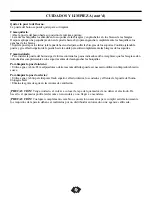
OPERATING INSTRUCTIONS
USING YOUR
RANGE
Top Burner Operation:
Note-
When boiling food, the highest temperature that can
be reached is the boiling point. When the liquid starts to
boil, decrease the size of the flame until you reach the
minimum flame that will hold the boil. This will save gas. It
will also decrease the possibilty of burning food or boiling
over, and help keep your kitchen cooler. Use stable
cookware with flat bottoms, and always place the cookware
on the burner grate before lighting the burner. Unstable or
rounded bottom cookware will not contact properly with the
grate and will affect the cooking efficiency. Select cookware
large enough to avoid spillovers, but remember, over-sized
cookware (diameters exceeding 8
1
/
2
”) can cause the range
finish to discolor or chip. Damage caused by oversized
cookware, such as those sometimes used in canning, are not
covered under warranty. The finish has been manufactured
to a commercially acceptable standard and its condition is
dependent upon the care of the user.
Temperature Selection:
It is important to select the proper temperature
setting. Never set the dial to a higher degree than
necessary, with the intention of lowering the setting
at a later time. This will not speed up cooking. It
can cause the oven to cycle slower and cause the
temperature to vary so that cooking results may be
unsatisfactory. Your oven has a temperature range of
250°F ~ 500°F.
6
Top Burner Valves:
The top burner flame size should be adjusted so that it does
not extend beyond the edge of the cookware. As a matter of
safety, it is urged that you comply with these instructions.A
high flame on a surface burner is both inefficient and
unsafe. The flame should always be adjusted so that it is no
larger than the bottom of a pan. Fluctuations in flame size
could be caused by pressure variations, improperly
positioned burners, damage, or debris.
Preheating:
Heat the oven to the desired temperature before placing
the food in the oven. Preheat for 10 to 12 minutes.
Opening the Oven Door:
Let hot air/steam escape before removing/replacing food.
Arranging Oven Rack:
The oven rack should be arranged before the oven is
turned “ON”. Place the rack so the food is centered in
the oven.
FLAME SIZE
TYPE OF COOKING
High
Start most foods; bring water to a boil;
pan-broiling.
Medium
Maintain a slow boil; Thicken sauces,
gravies; steaming.
Low
Keep foods cooking; poach; stewing.
Turn the knob to the full
LITE position when igniting
the top burners. Then adjust
the flame size so it does not
extend beyond the edge of
the cookware.
Note:
Know which knob
controls each burner. Place a
pan of food on the burner
before turning it on, and turn
the burner off before
removing the pan
Baking:
When baking, follow the recipe instructions. Use
correct ingredients, measure them carefully, and use
the correct type and size cookware suggested in the
recipe. Remember to preheat properly. Avoid
frequent opening of the oven door during preheating
and baking.
When baking cakes in glass baking dishes, lower
the oven temperature 25°F to prevent browning of
the bottom and sides before the top becomes
brown.Also, when using glass bakeware, it would
be better to increase the preheat time to have exact
stabilization of the oven’s temperature. To do so,
allow 20 minutes time for temperatures up to 350°F
and 30 minutes for temperatures up to 425°F. Avoid
opening the door as much as possible.
Oven Rack:
The oven rack should be arranged before the oven
knob is turned to an “ON” position. Place the rack
so the food is centered in the oven, not the rack.
When more than one dish is used, be sure to stagger
them, allowing space between each one. Do not
allow the dishes to touch any part of the oven,
especially the glass window.
Rack Removal:
Pull the oven rack forward and lift up on the front
of the rack so it will clear the rack keeper. To
replace the oven rack, guide the angled rear portion
of the rack under the rack keeper and slide the rack
to the rear. Never cover the oven rack with
aluminum foil. Such practices will trap heat and
cause intense heat in spots which usually give poor
results. It can damage the porcelain finish.








































